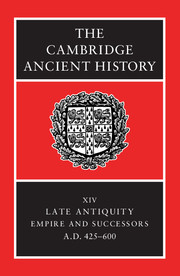Book contents
- Frontmatter
- PART I CHRONOLOGICAL OVERVIEW
- PART II GOVERNMENT AND INSTITUTIONS
- PART III EAST AND WEST: ECONOMY AND SOCIETY
- PART IV THE PROVINCES AND THE NON-ROMAN WORLD
- PART V RELIGION AND CULTURE
- 24 The organization of the church
- 25 Monasticism
- 26 Holy Men
- 27 The definition and enforcement of orthodoxy
- 28 Philosophy and philosophical schools
- 29 Education in the Roman empire
- 30 The visual arts
- 31 Building and architecture
- Conclusion
- Chronological Table
- BIBLIOGRAPHY
- Index
- References
31 - Building and architecture
from PART V - RELIGION AND CULTURE
Published online by Cambridge University Press: 28 March 2008
- Frontmatter
- PART I CHRONOLOGICAL OVERVIEW
- PART II GOVERNMENT AND INSTITUTIONS
- PART III EAST AND WEST: ECONOMY AND SOCIETY
- PART IV THE PROVINCES AND THE NON-ROMAN WORLD
- PART V RELIGION AND CULTURE
- 24 The organization of the church
- 25 Monasticism
- 26 Holy Men
- 27 The definition and enforcement of orthodoxy
- 28 Philosophy and philosophical schools
- 29 Education in the Roman empire
- 30 The visual arts
- 31 Building and architecture
- Conclusion
- Chronological Table
- BIBLIOGRAPHY
- Index
- References
Summary
INTRODUCTION
Buildings are the most tangible witnesses of the character of a civilization. Their scale, their function, their elaboration and their novelty as compared to earlier types are all significant pointers. A survey of architecture in the fifth and sixth century leads to one inescapable conclusion: mutatis mutandis, life in both city and countryside went on as before in areas under the effective control of the empire. If a citizen of Ephesus of a.d. 300 had been reborn in a.d. 600, he would not have found himself in an alien environment. The forum or agora remained a focus of city life (Fig. 43), as did the bath (Fig. 47) and circus. Of course, most of these traditional buildings were not newly built structures in late antiquity, since most cities had received lavish public buildings in the imperial period. Made to last, they needed upkeep but not replacement, unless they burnt or fell in an earthquake. Unless, therefore, a city was expanding (e.g. Constantinople (Fig. 40), Caesarea, Jerusalem, etc.), was a new foundation (Dara, Justiniana Prima (Fig. 41)) or had been raised in status (Dyrrhachium), there was little call for new public buildings. One novelty was the invasion of the city centres by large churches, but even in this domain, the essential structures had been architecturally developed in the century prior to a.d. 425, although there was still room for expansion. Other new architectural elements were monasteries (Figs. 49–50), martyria (Figs. 56–7) and welfare establishments.
- Type
- Chapter
- Information
- The Cambridge Ancient History , pp. 918 - 971Publisher: Cambridge University PressPrint publication year: 2001

